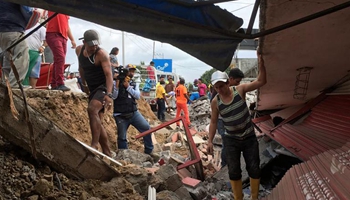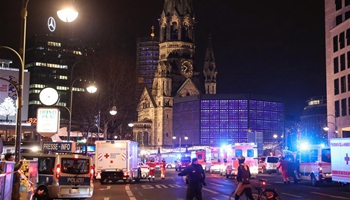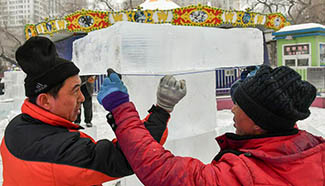BEIJING, Dec. 20 (Xinhua) -- As Beijing enters the fifth day since a red alert for air pollution was issued, severe smog lingers in the city and continues to plague people's lives.
From the top of a hill in Jingshan Park, usually a perfect spot for views of the Forbidden City, flocks of tourists wearing masks try to make out the imperial palace, but it is hidden in dense smog.
The smog has become such a common occurrence that many have given up hope that anything can be done about it.
"I am just getting used to it. It is not a short-term problem. Life goes on. What can you say?" says Zhang Xihua, 60, who visits the park every morning for exercise.
Beijing's red alert for air pollution came in to effect on December 15, as did the introduction of odd-even plate restrictions on vehicles, cutting traffic on roads by about half.
Kindergartens and primary schools have been ordered to suspend classes from Monday to Wednesday.
While staying at home, Xu Tiantian, a grade two student with Beijing Primary School, logged on to the Beijing Digital School website to take online classes.
Students without adults to take care of them at home are still being sent to school. An official with the Chinese Academy of Agriculture Sciences Elementary School says the school will properly arrange students' life and study and offer lunch as usual, but there will be no outdoor activities.
Beijing issued its first ever red alert in December 2015, but smog has long been a part of winter life for Beijingers.
"There are so many polluting plants around Beijing, but it is not practical to suddenly close them all down since the workers have to make a living," a taxi driver says.
During the red alert, Beijing's environmental protection and traffic control authorities are strengthening efforts to prevent pollution and maintain traffic order.
"After the red alert was activated, we arranged more policemen to help maintain order at major roads and intersections," says Xu Xianhui, vice head of the Xidan section of the Beijing Traffic Management Bureau.
With the odd-even plate restrictions in place, the city has also increased public transport services.
The passenger flow of ground public transport is expected to increase by 500,000 trips during the red alert. Some 3,600 extra buses are being added to the roads each day.
Beijing's subway is more crowded than usual at peak hours.
"Hopefully the smog will disappear soon. Compared to the subway it is more comfortable to drive home, but considering the environment it is good to drive less to reduce emission," says Dong Qi, a commuter who uses Subway Line 4.
The red alert is expected to be lifted on December 21 when air quality in the city is set to improve.










